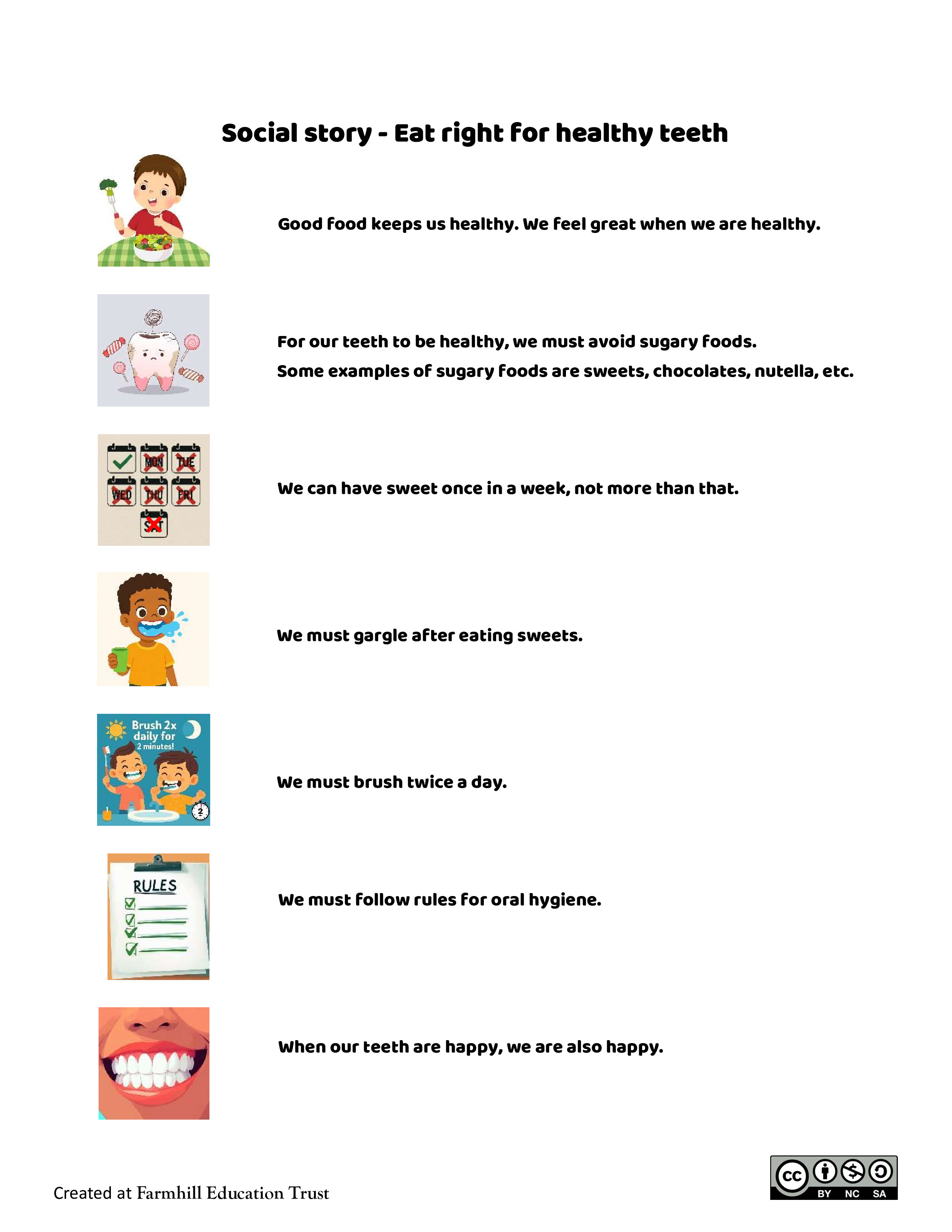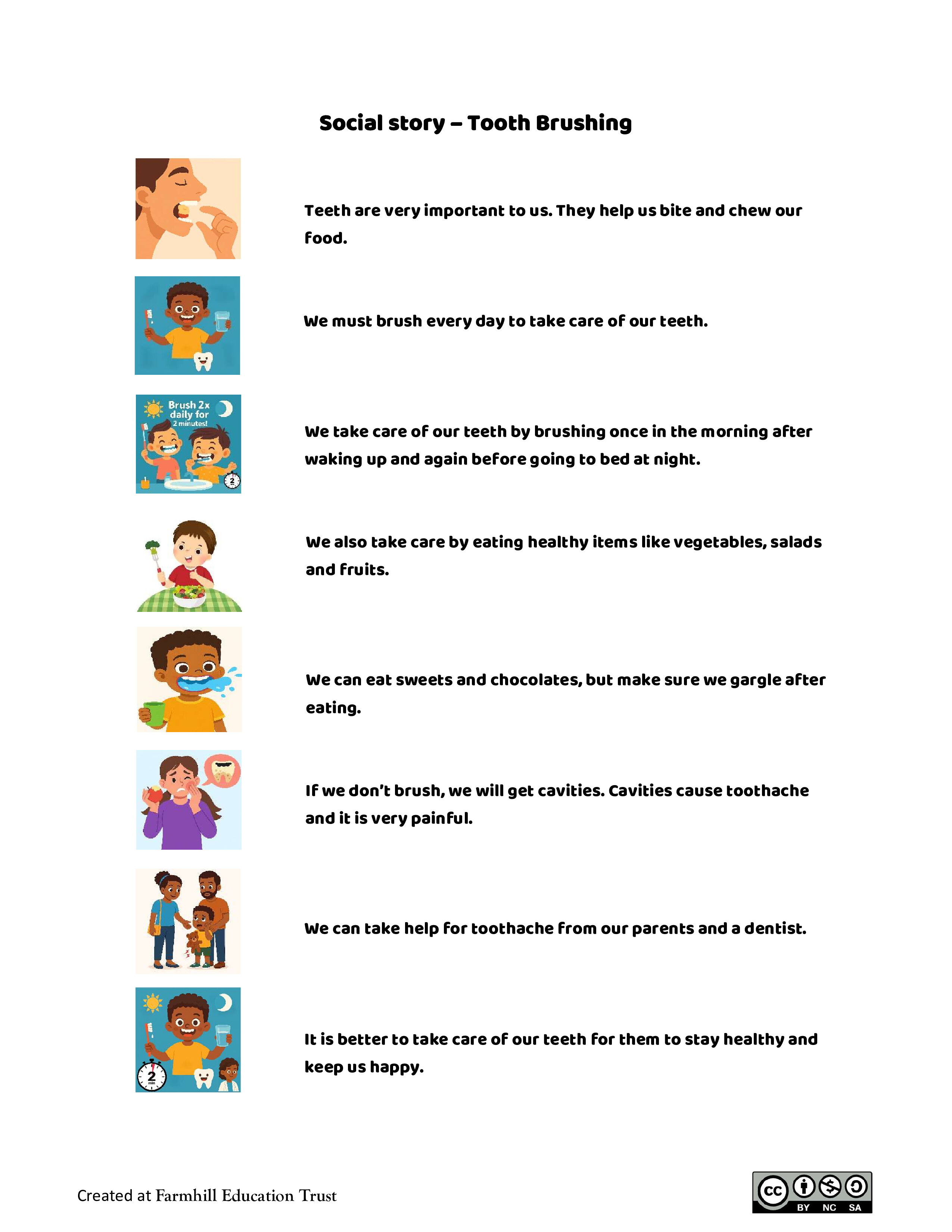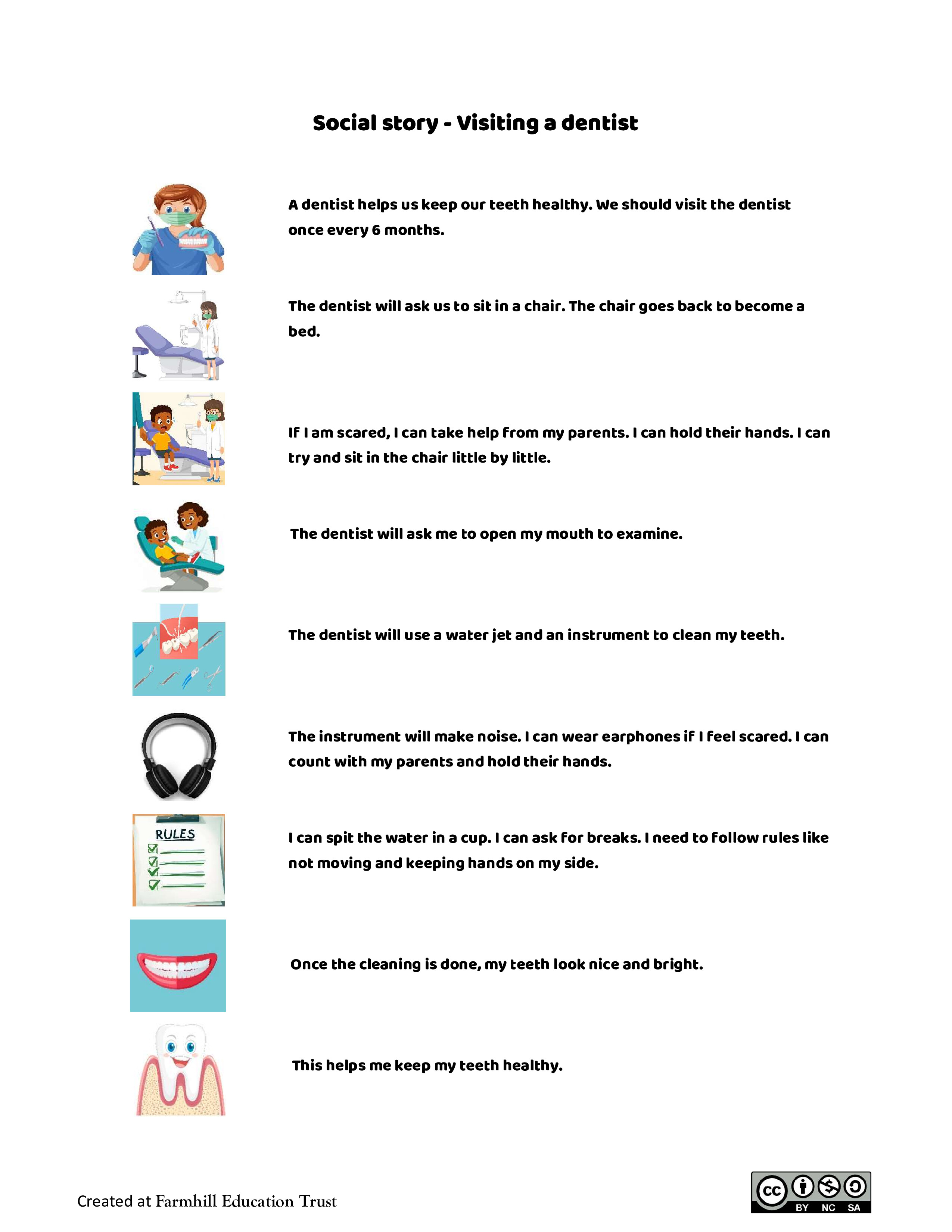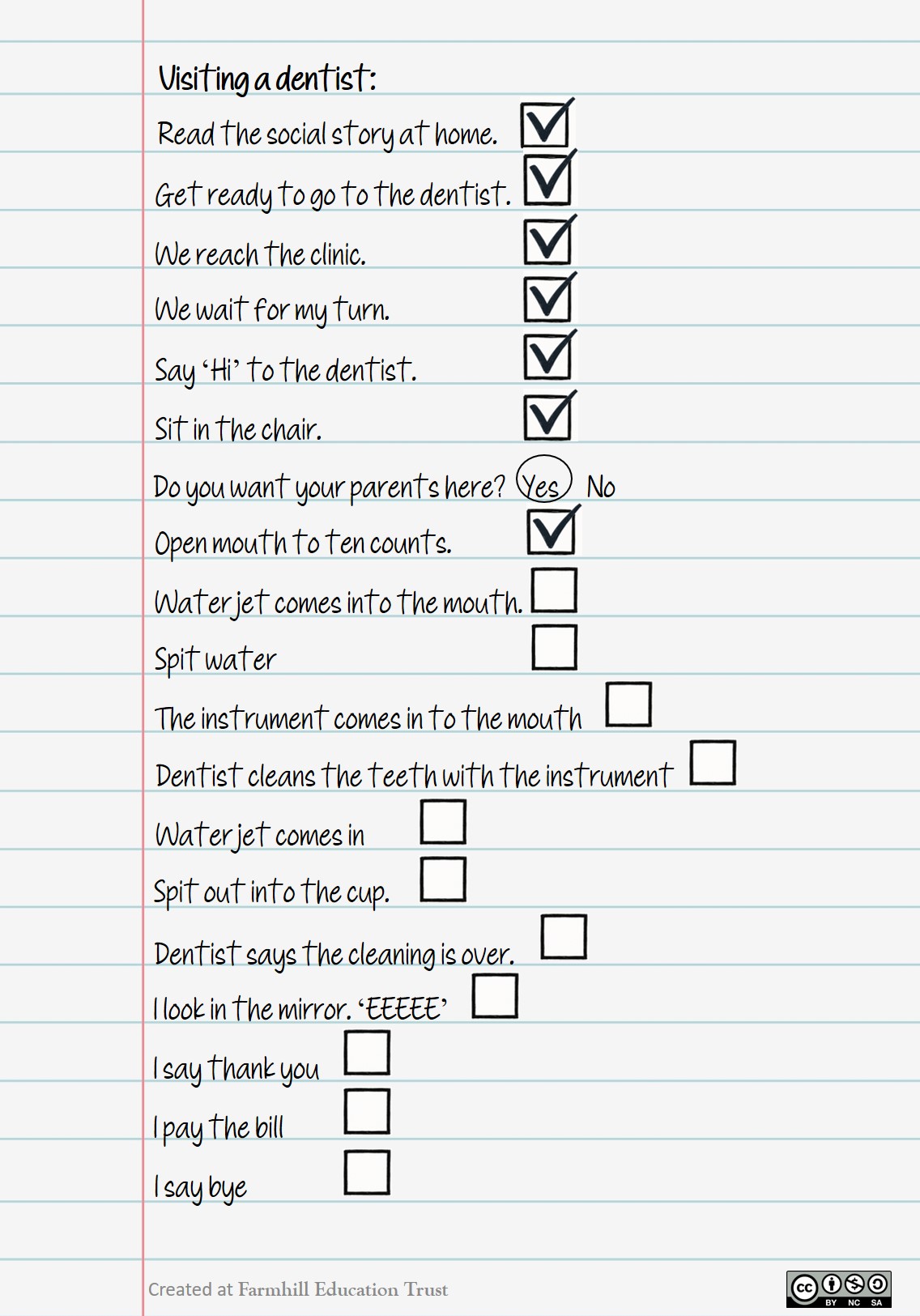17 Resource: Dental Care
Dental care is a difficult to deal with aspect of autism, as it relates to many sensory triggers that people on the spectrum experience. In the presence of oral sensitivities, children find it difficult to open mouth, allow a brush inside, use appropriate pressure to brush etc. The resulting lack of oral hygiene causes issues starting from gum infections to dental carries, causes pain, restricts eating, and negatively impacts the overall health of individuals on the spectrum.
Dental issues develop over a period of time when oral hygiene is not maintained. Dental problems also tend to be very painful impacting the mood and behavior of the autistic individual. On top of everything, going to dentist is also a difficult experience for many autistics. Therefore, preventive care becomes very important. The following information is focused on enabling dental care for young children.
17.1 Tools included and how to use
This resource includes two types of tools - Social Stories and Visual Lessons.
Visual Lessons
Lessons and activities built around a visual structure like a graphic story book offer several advantages for helping autistic children learn activities of daily living (ADLs) by leveraging their visual learning strengths and providing structured, engaging ways to practice essential life skills.
Here are some ways to use visual lessons.
Joint Reading and Shared Attention: Read the book together, pointing to pictures and discussing each step. Encourage the child to ask questions or make comments about the story.
Visual Schedules: Use illustrations from the book to create visual schedules or checklists for daily routines, breaking down complex tasks into manageable steps.
Role-Playing and Reenactment: After reading, have the child practice the activity by following the sequence shown in the book. For example, after reading a story about brushing teeth, guide the child through the real-life steps using the book as a reference.
Activities: Select appropriate activities included in the graphic story book and do them with the child.
Personalization: Optionally, you can customize the books or activities to include the child’s own experiences, familiar people, or specific routines to increase relevance and engagement.
Repetition and Reinforcement Read the same book multiple times to reinforce learning. Repetition helps children internalize routines and build confidence in performing ADLs independently.
About the activities
All the activities included with the graphic story books are anchored around conversations and discussions, which depend on facilitator’s ability to ask the right questions, modify them as necessary and go with the responses. The objective of the activities is to ensure the learner participates and engages along with the facilitator, and not to test the knowledge or to challenge the learner. The nature of the activities, the visuals and the discussions, is such that by engaging in these activities, the learner is bound to learn. Therefore the key is to get the learner’s cooperation, participation and engagement. Even if the learner does not respond with completely correct answers, it is likely they will learn to implement the steps in their daily lives.
A note for parents
All parents want their childrren to learn and look forward to that happy moment of learning. However, it is important to remember each child is different and has their own ways of being and responding. We can learn to understand there are and will be differences between parents’ expectations and what the child is able to do or demonstrate at any point in time. Please seek help from an expert or the child’s therapist when you are unable to get a desired response from the child or feel stuck at any point.
17.2 Preventive Dental care
Preventive dental care includes three important, related areas - food and Hygiene habits, Toothbrushing, Visiting a dentist. By focusing on enabling preventive care, we empower autistic individuals to engage in dental care mindfully, to self manage wherever possible and to make healthy choices. The following information is focused on enabling preventive dental care in young children.
17.3 Food and Hygiene Habits
Getting children to eat healthy foods is one of the primary aspects of oral hygiene. We need to think of well balanced diet in this context. Children should also eat fibre rich food which needs chewing so that their gums are exercised and the spaces between the teeth remains cleaner.
Key things to keep in mind are:
Eating foods that have lots of sugar is bad for teeth
Having too much milk during the night or through the night, not gargling or cleaning the mouth afterwards are more likely to cause cavities
Eating over-mashed soft food is not good for oral health. Cheese, beans, fresh fruits, raw vegetables, leafy greens are good for the teeth.
Fizzy drinks, acidic fruits and sweets are bad for teeth.
Common Behaviors that impact dental health
Mouthing: Some children tend to keep everything in the mouth. That results in many microbes going into the body.
Chewing: Some children keep everything in their mouth and also chew on them. This is bad for oral hygiene and may also cause injury to teeth and gums.
Biting: Some children bite everything, like the edge of a table. Biting into really hard surfaces or things may damage the teeth.
17.4 Recources and tools for Food and Hygiene Habits
Planning to eat healthy
Eating is a part of lifestyle. Also, modelling is very powerful. So, any change we expect in the food habits of the child has to be implemented by the entire family.
The family should have a good routine for waking up and getting physical activity in the morning. It is important to drink water to stimulate bowel movement and build a sense of hunger. This is especially important for poor eaters.
It is important to plan balanced meals. Have a weekly meeting to plan the menu. Make space for favourite foods like samosas, popcorn or chicken burgers. Decide on the quantities. Even if your child is not verbal, make them a part of the meeting and let them respond with yes or no. All this activity builds predictability and reduces anxiety about favourite foods. You can use the menu as an opportunity to build communication, create a sense of time through the calendar, build it into their weekly schedule, help them get into the habit of checking written instructions or schedules instead of asking the same questions again and again…the possibilities are endless! Remember children love food and it is a great motivator. Refer to our resource on eating for more about managing children’s eating habits.
Addressing eating issues
Children may have restrictive eating habits, texture sensitivities, chewing issues or may eat too fast or too slow. Based on the severity of the problem, we can choose eating interventions to address these issues. Refer to our resource on eating for more about addressing eating issues.
Oral Hygiene Graphic Story Book and activities
This Oral Hygiene book introduces ideas like the importance of healthy teeth, avoding sugary foods, and the need to brush daily. The activities included reinforce these ideas. Sample pages and a download link are below.
Chewing Graphic Story Book and Activities
The graphic story book below focuses on the importance of chewing food, what to chew and what not to etc. The accompanying activities reinforce the same ideas.
17.5 Tooth Brushing
Most of the children with autism face issues with brushing. Tooth brushing is managed ‘some how’. Some times, the strategies that are used to ensure children brush their teeth can result in trauma for the child, engendering negative attitudes towards brushing, and resulting in a lot of distress.
A variety of issues that are often seen with children on the spectrum are - Unable to open mouth to brush, Unable to allow a brush inside the mouth, eats away the toothpaste, Unable to gargle, Unable to spit, Putting too much or too little pressure while brushing etc.
What can a parent do
Identify the issue - The specific issue that a child has to be identified correctly so an intervention can be planned. The person facilitating brushing needs to be clear with what the autistic person finds challenging and plan support accordingly. Not everyone needs everything. If it is a sensory issue, a separate intervention needs to be planned based on the issue - for example, getting specific kinds of toothbrushes like vibration brush, using specific flavoured toothpastes, planning specific massages to prepare the child for brushing.
Acknowledge the difficulty - It is important to acknowledge the issues that the autistic person has with brushing Avoid feedback such as ‘Drama, ‘Too much’, ‘everyone does brushing, what’s your problem’ etc. Rather, you can say, ‘I understand you are quite upset about brushing. Let us follow schedule and I am here to help you go through it’.
Preparation - Preparation plays a huge role in developing a favourable attitude to brushing. Having a visual schedule which shows when it is time to brush is one of the key steps. Social stories and general story books about brushing can also help preparation.
Tooth brushing graphic story book
Tooth brushing graphic story book focuses on the importance of brushing teeth, and provides a visual structure for tooth brushing. The activities included reinforce the same.
Supporting tooth brushing
Visual prompt for toothbrushing
This is a video demonstrating the use of visual prompts to teach toothbrushing. This child has all the skills needed for brushing. He needs help with following a sequence. A visual prompt is a picture that the child/person refers to during the process. There is absolutely no need to give any kind of instruction. Notice that the facilitator does not say anything in the entire video. The facilitator just points to the picture and the child follows. The facilitator also gives counts where repetitions are needed. This ensures that the brushing is done for at least 2 minutes.
The child could follow the sequence when the facilitator pointed to the picture. The facilitator did not say anything through out the video. This is crucial for the prompt to stay with the visual and not with the facilitator. The child kept referring to the visual prompt with support in the video. Eventually, the child learns to follow the visual by himself and follow the sequence. The child learns to brush by himself.
Modelling and Physical Prompts
A visual prompt works when a person has the skills to perform the different steps as shown in the prompt. What do we do when the person is not independently able to perform some steps?
This video shows such a situation where we use a combination of visual, modelling and physical prompts. As a prerequisite, we need to have some idea of what the person can do independently and where they may need more help than just the visual.
Visual prompt: We point to the visual prompt for the steps the person is able to perform independently.
Modelling prompt: We use modelling for steps where the person can perform the action imitating the facilitator. Notice that the facilitator points to the visual, says ‘Do this’ and then performs the action. The person imitates. Notice that the only instruction is ‘Do this’ for modeling. Also, facilitator says ‘Do this’ to get the person’s attention. If the person is already looking at the facilitator, even this instruction is unnecessary. Modelling can be done without instruction.
Physical prompt: When the person finds it difficult to perform a step, the facilitator holds the hand and supports them to do the task. Notice that the facilitator points to the visual, holds the person’s hand and then he performs the action. The physical prompt does not need any instruction.
The facilitator also gives counts where repetitions are needed. This ensures that the brushing is done for at least 2 minutes.
As the person becomes more fluent and independent in each of the stps, physical prompts can become modelling prompts, modelling can become visual prompt and eventually, the support can also be removed completely as the person starts to brush by themselves.
17.6 Visiting a Dentist
The final aspect of Preventive care is visiting a dentist periodically.
Visiting a dentist periodically and learning to interact with the doctor, the people and the environment are important goals to pursue. It will facilitate preventive care which will aid good oral hygiene, education about dental hygiene as well as taking help when there is a need.
However, it is important that the parents or the caretakers understand how challenging it is for the autistic person. The environment at a dentist’s place can be daunting for a person who has never been there. A chair that leans back gradually could throw a person into panic mode. The caretaker as well as the clinic must be sensitive to these experiences and expressions and respond with empathy. The caretakers should ideally carry whatever mode of communication the child uses so that they are able to respond by themselves.
Do not hesitate to take a step back if the person wants to stop the process mid way. Just leave everything and go home. You can always prepare again and come. Instead, if you push through, it will cause trauma to the autistic person and any future references to a dentist might result in lots of emotional outbursts.
What can a parent do
Preparation - Preparation helps in building cooperation and managing anxiety around a new place and people. Dentist visit can be marked on a calendar. Social story can help in preparation. A check list can help by keeping things predictable.
Visiting a dentist check list
Please note that these resources and interventions are shared for general guidance. Designing and executing interventions - more importantly - noticing how the child responds and modifying the interventions so the child does not get distressed, is a specialist job. Consult qualified therapists as necessary.




Social Stories
Social stories are a widely used tool to support autistic children in understanding and navigating everyday situations. These stories are simple, tailored narratives that break down complex behaviors into clear, manageable steps, helping children learn what to expect and how to respond in various settings. Social stories are also used to introduce and reinforce various day to day behaviours.
Social stories can be presented in various formats, including written narratives, pictures, or even videos. They are often read repeatedly to reinforce learning and are most effective when used just before the situation they describe